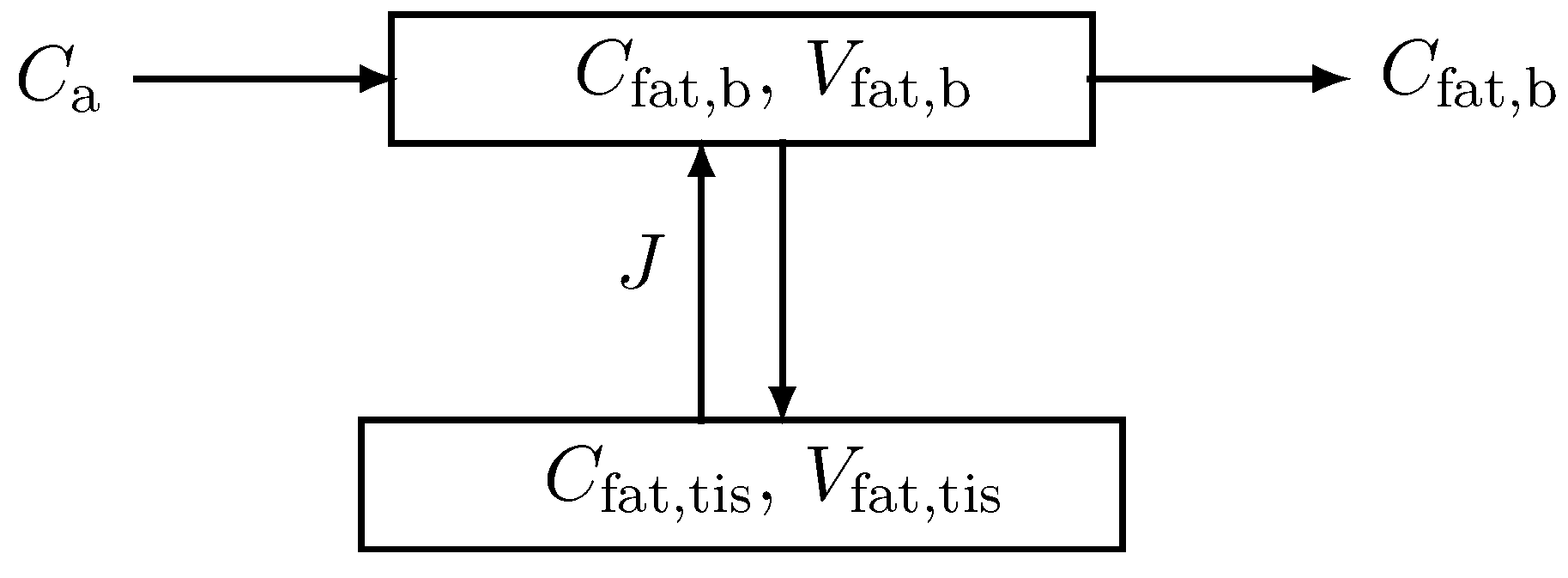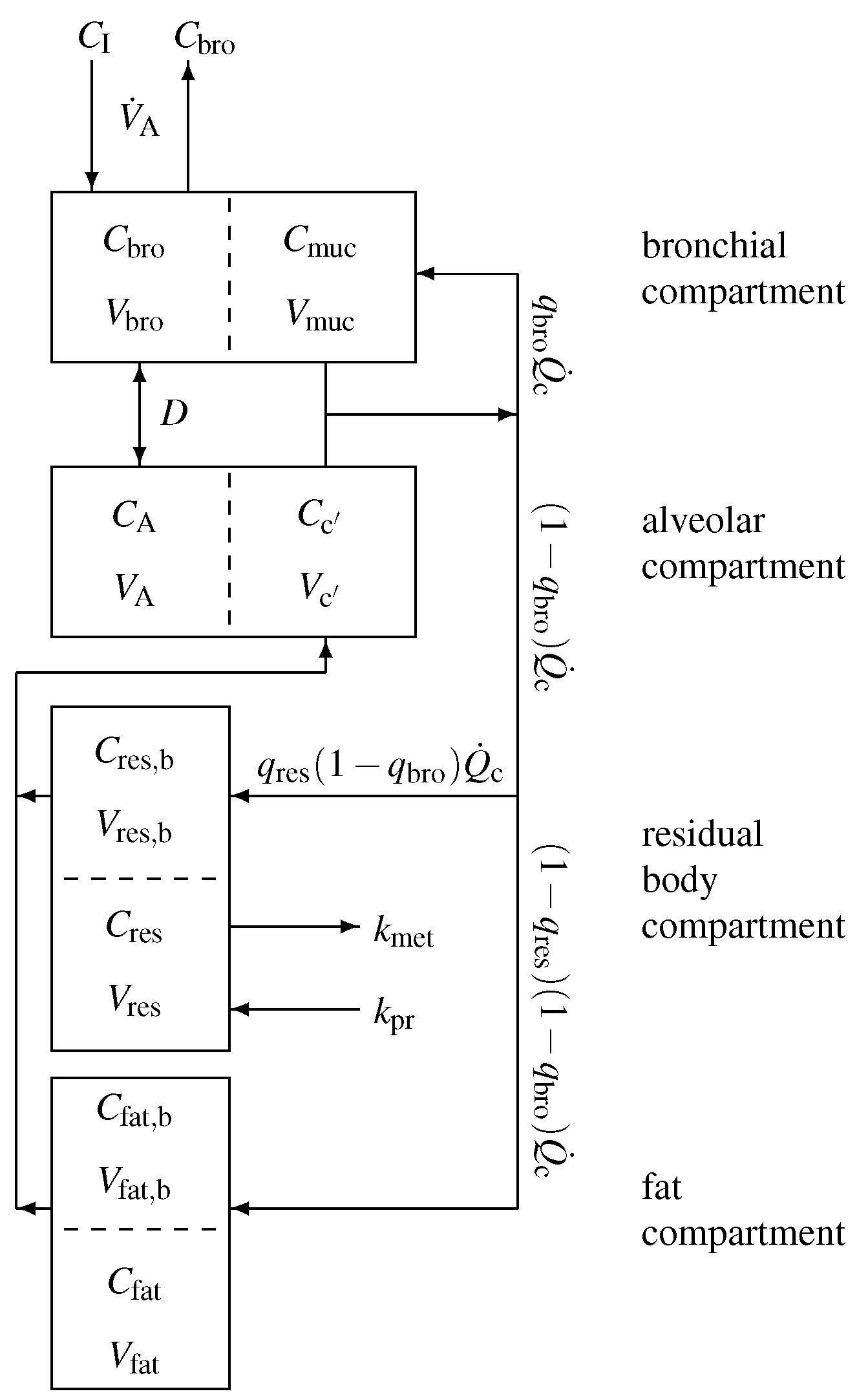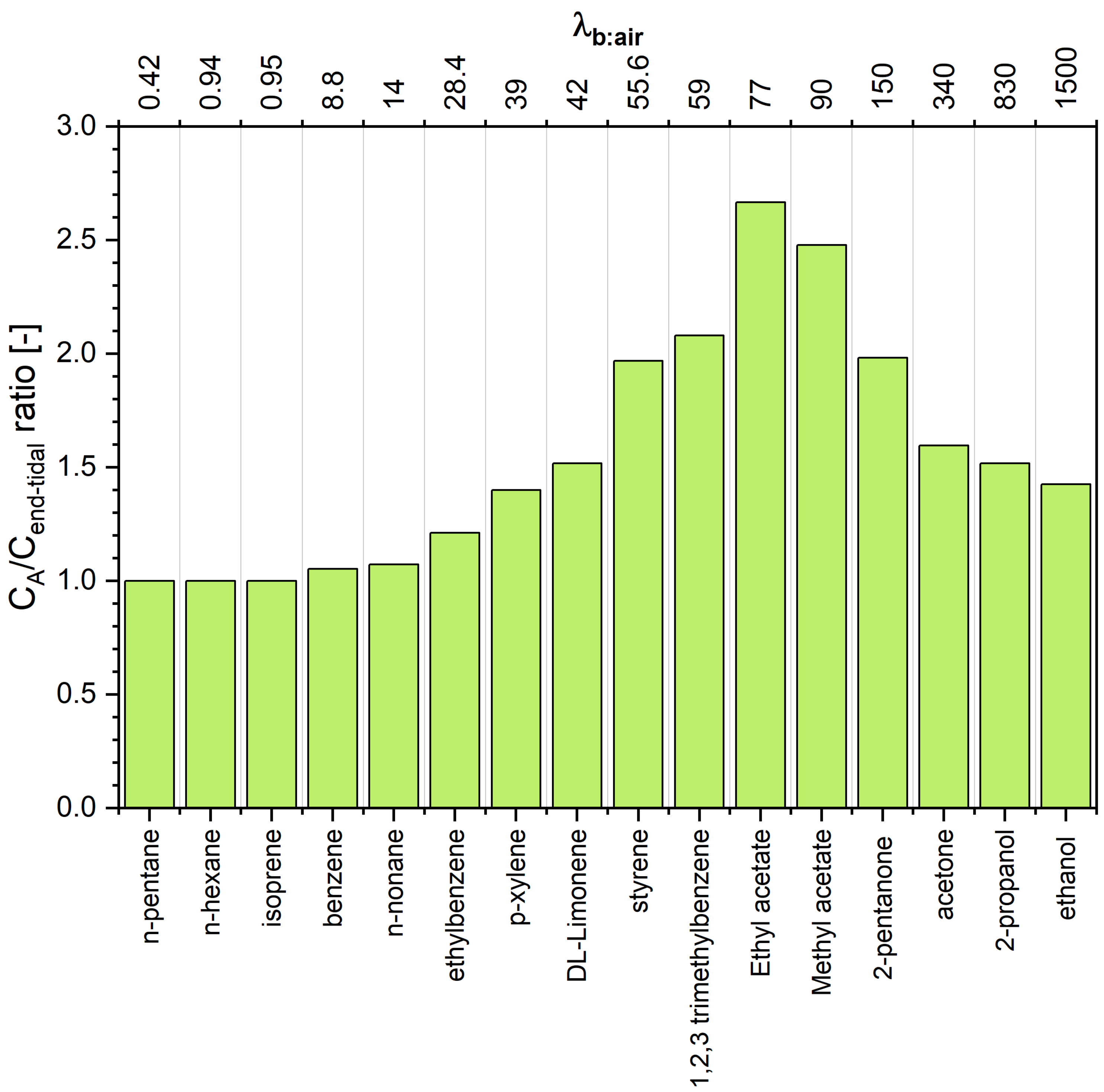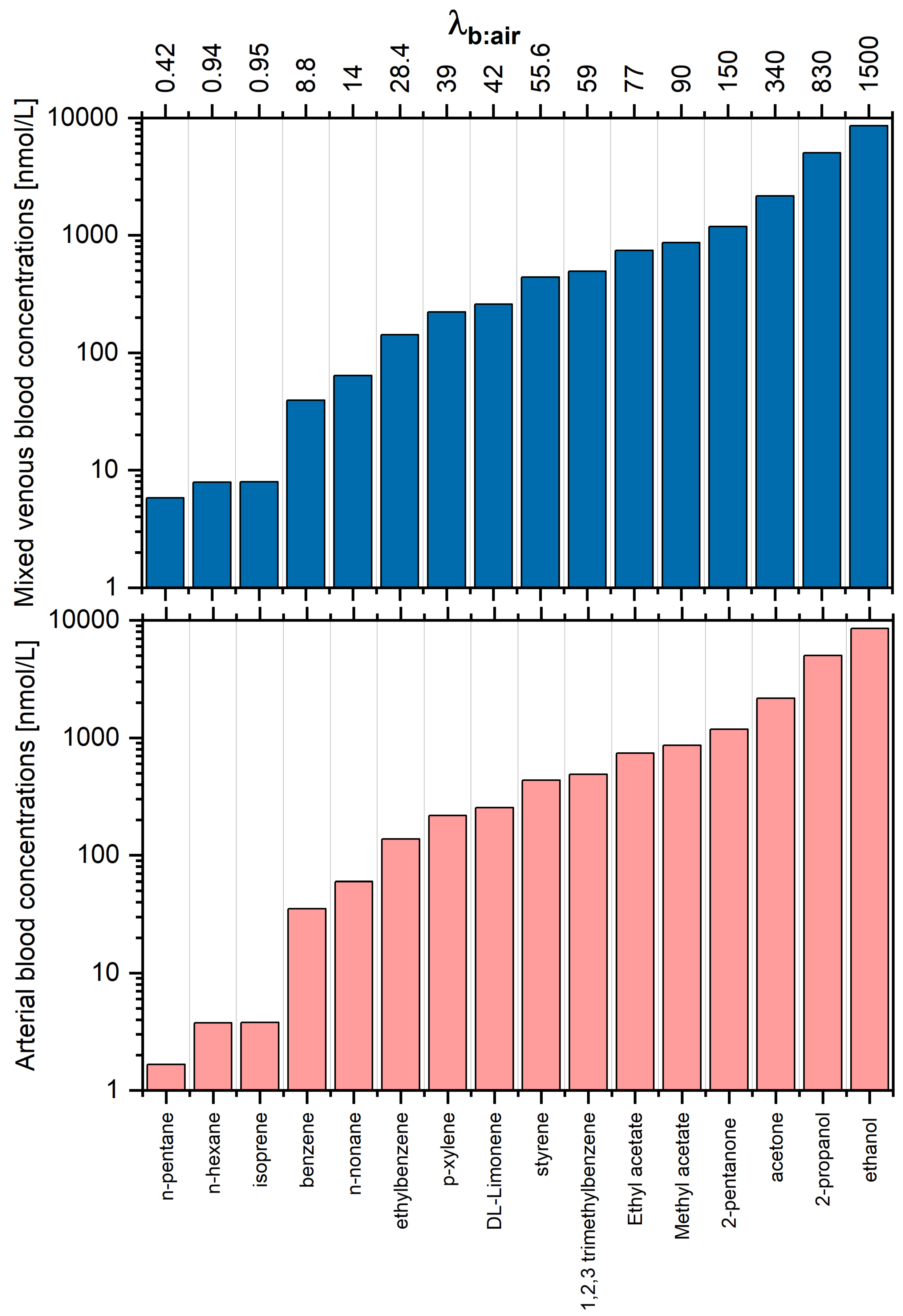Modelling of Breath and Various Blood Volatilomic Profiles—Implications for Breath Volatile Analysis
Abstract
:1. Introduction
2. Methods
2.1. Modelling VOC Concentrations in Different Body Regions
- (i)
- a fat compartment with concentration (with no production and no metabolism of the VOC under consideration in the fat compartment);
- (ii)
- a residual body compartment containing all the rest of the body with concentration (with possible production and metabolism).
- (2a)
- if (and assuming no hyperventilation) we set , which simplifies the formulae considerably;
- (2b)
- if or when hyperventilating.
2.2. Derivation of the Formulae for Case 1
2.3. Derivation of the Formulae for Case 2,
2.3.1. Case 2a:
2.3.2. Case 2b: or
2.4. Nominal Data for Modelling
3. Results
3.1. Alveolar Air versus End-Tidal Air
3.2. Blood and Fat VOC Signatures
4. Conclusions
Author Contributions
Funding
Acknowledgments
Conflicts of Interest
Abbreviations
| Parameter | Symbol |
| Compartment concentrations | |
| bronchioles | , |
| alveoli | |
| arterial | |
| mixed-venous | |
| residual body | |
| fat | |
| inhaled (ambient) | |
| Compartment volumes | |
| bronchioles | |
| mucosa | |
| alveoli | |
| fat | |
| residual body | |
| Fractional blood flows at rest | |
| fractional flow bronchioles | |
| fractional flow fat | |
| fractional residual flow | |
| Partition coefficients | |
| blood:air | |
| blood:residual body | |
| blood:fat | |
| mucosa:air | , |
| mucosa:blood | |
| fat:air | |
| Physiological parameters | |
| linear metabolic rate | |
| endogenous production | |
| cardiac output | |
| alveolar ventilation | |
| conductance parameter | D |
Appendix A

References
- Beauchamp, J.; Davis, C.; Pleil, J. (Eds.) Breathborne Biomarkers and the Human Volatilome, 2nd ed.; Elsevier: Boston, MA, USA, 2020. [Google Scholar]
- King, J.; Koc, H.; Unterkofler, K.; Mochalski, P.; Kupferthaler, A.; Teschl, G.; Teschl, S.; Hinterhuber, H.; Amann, A. Physiological modeling of isoprene dynamics in exhaled breath. J. Theor. Biol. 2010, 267, 626–637. [Google Scholar] [CrossRef] [PubMed] [Green Version]
- King, J.; Kupferthaler, A.; Unterkofler, K.; Koc, H.; Teschl, S.; Teschl, G.; Miekisch, W.; Schubert, J.; Hinterhuber, H.; Amann, A. Isoprene and acetone concentration profiles during exercise on an ergometer. J. Breath Res. 2009, 3, 027006. [Google Scholar] [CrossRef] [PubMed]
- King, J.; Kupferthaler, A.; Frauscher, B.; Hackner, H.; Unterkofler, K.; Teschl, G.; Hinterhuber, H.; Amann, A.; Högl, B. Measurement of endogenous acetone and isoprene in exhaled breath during sleep. Physiol. Meas. 2012, 33, 413. [Google Scholar] [CrossRef] [PubMed] [Green Version]
- Unterkofler, K.; King, J.; Mochalski, P.; Jandacka, M.; Koc, H.; Teschl, S.; Amann, A.; Teschl, G. Modeling-based determination of physiological parameters of systemic VOCs by breath gas analysis: A pilot study. J. Breath Res. 2015, 9, 036002. [Google Scholar] [CrossRef]
- King, J.; Unterkofler, K.; Teschl, G.; Teschl, S.; Koc, H.; Hinterhuber, H.; Amann, A. A mathematical model for breath gas analysis of volatile organic compounds with special emphasis on acetone. J. Math. Biol. 2011, 63, 959–999. [Google Scholar] [CrossRef] [Green Version]
- King, J.; Unterkofler, K.; Teschl, G.; Teschl, S.; Mochalski, P.; Koc, H.; Hinterhuber, H.; Amann, A. A modeling based evaluation of isothermal rebreathing for breath gas analysis of highly soluble volatile organic compounds. J. Breath Res. 2012, 6, 016005. [Google Scholar] [CrossRef]
- Ager, C.; Unterkofler, K.; Mochalski, P.; Teschl, S.; Teschl, G.; Mayhew, C.A.; King, J. Modeling-based determination of physiological parameters of systemic VOCs by breath gas analysis, part 2. J. Breath Res. 2018, 12, 036011. [Google Scholar] [CrossRef]
- Anderson, J.C.; Babb, A.L.; Hlastala, M.P. Modeling soluble gas exchange in the airways and alveoli. Ann. Biomed. Eng. 2003, 31, 1402–1422. [Google Scholar] [CrossRef]
- West, J.B. Respiratory Physiology. The Essentials, 7th ed.; Lippincott Williams & Wilkins: Baltimore, MD, USA, 2005. [Google Scholar]
- Lumb, A.B. Nunn’s Applied Respiratory Physiology, 6th ed.; Butterworth-Heinemann: Oxford, UK, 2005. [Google Scholar]
- Staudinger, J.; Roberts, P.V. A critical compilation of Henry’s law constant temperature dependence relations for organic compounds in dilute aqueous solutions. Chemosphere 2001, 44, 561–576. [Google Scholar] [CrossRef]
- Sander, R. Compilation of Henry’s law constants (version 4.0) for water as solvent. Atmos. Chem. Phys. 2015, 15, 4399–4981. [Google Scholar] [CrossRef] [Green Version]
- Farhi, L.E. Elimination of inert gas by the lung. Respir. Physiol. 1967, 3, 1–11. [Google Scholar] [CrossRef]
- Anderson, J.C.; Lamm, W.J.; Hlastala, M.P. Measuring airway exchange of endogenous acetone using a single-exhalation breathing maneuver. J. Appl. Physiol. 2006, 100, 880–889. [Google Scholar] [CrossRef] [PubMed] [Green Version]
- Poulin, P.; Krishnan, K. An algorithm for predicting tissue: Blood partition coefficients of organic chemicals from n-octanol: Water partition coefficient data. J. Toxicol. Environ. Health 1995, 46, 117–129. [Google Scholar] [CrossRef] [PubMed]
- Amann, A.; Costello, B.; Miekisch, W.; Schubert, J.; Buszewski, B.; Pleil, J.; Ratcliffe, N.; Risby, T. The human volatilome: Volatile organic compounds (VOCs) in exhaled breath, skin emanations, urine, feces and saliva. J. Breath Res. 2014, 8, 034001. [Google Scholar] [CrossRef]
- Kramer, C.; Mochalski, P.; Unterkofler, K.; Agapiou, A.; Ruzsanyi, V.; Liedl, K.R. Prediction of blood:air and fat:air partition coefficients of volatile organic compounds for the interpretation of data in breath gas analysis. J. Breath Res. 2016, 10, 017103. [Google Scholar] [CrossRef] [Green Version]
- King, J.; Mochalski, P.; Kupferthaler, A.; Unterkofler, K.; Koc, H.; Filipiak, W.; Teschl, S.; Hinterhuber, H.; Amann, A. Dynamic profiles of volatile organic compounds in exhaled breath as determined by a coupled PTR-MS/GC-MS study. Physiol. Meas. 2010, 31, 1169–1184. [Google Scholar] [CrossRef]
- Szabo, A.; Unterkofler, K.; Mochalski, P.; Jandacka, M.; Ruzsany, V.; Szabo, G.; Mohacsi, A.; Teschl, S.; Teschl, G.; King, J. Modeling of breath methane concentration profiles during exercise on an ergometer. J. Breath Res. 2016, 10, 017105. [Google Scholar] [CrossRef]
- Ager, C.; Mochalski, P.; King, J.; Mayhew, C.A.; Unterkofler, K. Effect of inhaled acetone concentrations on exhaled breath acetone concentrations at rest and during exercise. J. Breath Res. 2020, 14, 026010. [Google Scholar] [CrossRef]
- Hlastala, M.P. The alcohol breath test—A review. J. Appl. Physiol. 1998, 84, 401–408. [Google Scholar] [CrossRef] [PubMed]
- O’Hara, M.E.; Clutton-Brock, T.H.; Green, S.; O’Hehir, S.; Mayhew, C.A. Mass spectrometric investigations to obtain the first direct comparisons of endogenous breath and blood volatile organic compound concentrations in healthy volunteers. Int. J. Mass Spectrom. 2009, 281, 92–96. [Google Scholar] [CrossRef]
- O’Hara, M.E.; Clutton-Brock, T.H.; Green, S.; Mayhew, C.A. Endogenous volatile organic compounds in breath and blood of healthy volunteers: Examining breath analysis as a surrogate for blood measurements. J. Breath Res. 2009, 3, 027005. [Google Scholar] [CrossRef] [PubMed]
- Mochalski, P.; King, J.; Klieber, M.; Unterkofler, K.; Hinterhuber, H.; Baumann, M.; Amann, A. Blood and breath levels of selected volatile organic compounds in healthy volunteers. Analyst 2013, 138, 2134–2145. [Google Scholar] [CrossRef] [PubMed] [Green Version]
- Apolonski, A.; Roy, S.; Lampe, R.; Maiti, K.S. Molecular identification of bio-fluids in gas phase using infrared spectroscopy. Appl. Opt. 2020, 59, E36–E41. [Google Scholar] [CrossRef] [PubMed]
- Mochalski, P.; Unterkofler, K. Quantification of selected volatile organic compounds in human urine by gas chromatography selective reagent ionization time of flight mass spectrometry (GC-SRI-TOF-MS) coupled with head-space solid-phase microextraction (HS-SPME). Analyst 2016, 141, 4796–4803. [Google Scholar] [CrossRef] [PubMed] [Green Version]
- Thorn, R.M.S.; Greenman, J. Microbial volatile compounds in health and disease conditions. J. Breath Res. 2012, 6, 024001. [Google Scholar] [CrossRef]





| Compound | D | |||||||||
|---|---|---|---|---|---|---|---|---|---|---|
| Name | 37 °C | 32 °C | nmol/L | L/min | ||||||
| n-pentane | 0.42 | 39.60 | 0.02 | 0.02 | 4.0 | 4.0 | 1.66 | 5.81 | 158.00 | ∞ |
| hexane | 0.94 | 104.00 | 0.01 | 0.01 | 4.0 | 4.0 | 3.75 | 7.91 | 415.34 | ∞ |
| isoprene | 0.95 | 61.50 | 0.19 | 0.24 | 4.0 | 4.0 | 3.79 | 7.95 | 245.61 | ∞ |
| benzene | 8.80 | 321.50 | 2.93 | 3.48 | 4.0 | 4.0 | 35.14 | 39.30 | 1283.95 | ∞ |
| benzene | 8.80 | 321.50 | 2.93 | 3.48 | 4.0 | 4.2 | 36.86 | 41.05 | 1348.70 | 111 |
| n-nonane | 13.90 | 831.00 | 0.0020 | 0.0028 | 4.0 | 4.3 | 59.66 | 63.85 | 3331.96 | 76 |
| ethylbenzene | 28.40 | 1764.00 | 1.71 | 2.21 | 4.0 | 4.8 | 137.63 | 141.82 | 7049.48 | 25 |
| p-xylene | 38.90 | 2020.00 | 2.36 | 2.85 | 4.0 | 5.6 | 217.49 | 221.69 | 11,294.00 | 12 |
| DL-Limonene | 42.00 | 5700.00 | 0.89 | 1.12 | 4.0 | 6.1 | 254.03 | 258.23 | 34,475.60 | 9 |
| styrene | 55.60 | 3180.00 | 4.54 | 5.67 | 4.0 | 7.9 | 435.55 | 439.74 | 24,910.70 | 3.32 |
| 1,2,3-trimethylbenzene | 59.10 | 10,200.00 | 2.73 | 3.41 | 4.0 | 8.3 | 489.15 | 493.35 | 84,422.30 | 2.56 |
| Acetic acid ethyl ester | 76.80 | 176.00 | 67.49 | 87.68 | 4.0 | 9.6 | 737.00 | 741.19 | 1688.95 | 0.68 |
| Acetic acid ethyl ester | 76.80 | 176.00 | 67.49 | 87.68 | 4.0 | 10.7 | 813.80 | 817.99 | 1864.95 | 0 |
| methyl ester | 90.10 | 85.70 | 114.04 | 149.84 | 4.0 | 9.6 | 860.14 | 864.33 | 818.13 | 0.25 |
| methyl ester | 90.10 | 85.70 | 114.04 | 149.84 | 4.0 | 9.9 | 888.12 | 892.31 | 844.75 | 0 |
| 2-pentanone | 150.00 | 372.00 | 148.25 | 189.95 | 4.0 | 7.9 | 1182.64 | 1186.84 | 2933.0 | 0.003 |
| 2-pentanone | 150.00 | 372.00 | 148.25 | 189.95 | 4.0 | 7.9 | 1182.88 | 1187.07 | 2933.53 | 0 |
| acetone | 340.00 | 86.00 | 316.10 | 406.75 | 4.0 | 6.4 | 2162.56 | 2166.75 | 547.00 | 0 |
| 2-propanol | 830.00 | 180.00 | 1278.47 | 1777.94 | 4.0 | 6.1 | 5025.01 | 5029.21 | 1089.76 | 0 |
| ethanol | 1500.00 | 215.00 | 2228.64 | 3021.70 | 4.0 | 5.7 | 8537.44 | 8541.63 | 1223.70 | 0 |
| hyperventilating | 4.0 | 7.6 | 2577.89 | 2586.28 | 652.06 | 0 | ||||
| with V = 10.4 L/min | 7.4 | 2509.68 | 2518.07 | 634.80 | 1 | |||||
| acetone | 6.8 | 2299.34 | 2307.73 | 581.60 | 5 | |||||
| 6.3 | 2124.60 | 2132.99 | 537.40 | 10 |
Publisher’s Note: MDPI stays neutral with regard to jurisdictional claims in published maps and institutional affiliations. |
© 2022 by the authors. Licensee MDPI, Basel, Switzerland. This article is an open access article distributed under the terms and conditions of the Creative Commons Attribution (CC BY) license (https://creativecommons.org/licenses/by/4.0/).
Share and Cite
Mochalski, P.; King, J.; Mayhew, C.A.; Unterkofler, K. Modelling of Breath and Various Blood Volatilomic Profiles—Implications for Breath Volatile Analysis. Molecules 2022, 27, 2381. https://doi.org/10.3390/molecules27082381
Mochalski P, King J, Mayhew CA, Unterkofler K. Modelling of Breath and Various Blood Volatilomic Profiles—Implications for Breath Volatile Analysis. Molecules. 2022; 27(8):2381. https://doi.org/10.3390/molecules27082381
Chicago/Turabian StyleMochalski, Paweł, Julian King, Chris A. Mayhew, and Karl Unterkofler. 2022. "Modelling of Breath and Various Blood Volatilomic Profiles—Implications for Breath Volatile Analysis" Molecules 27, no. 8: 2381. https://doi.org/10.3390/molecules27082381






